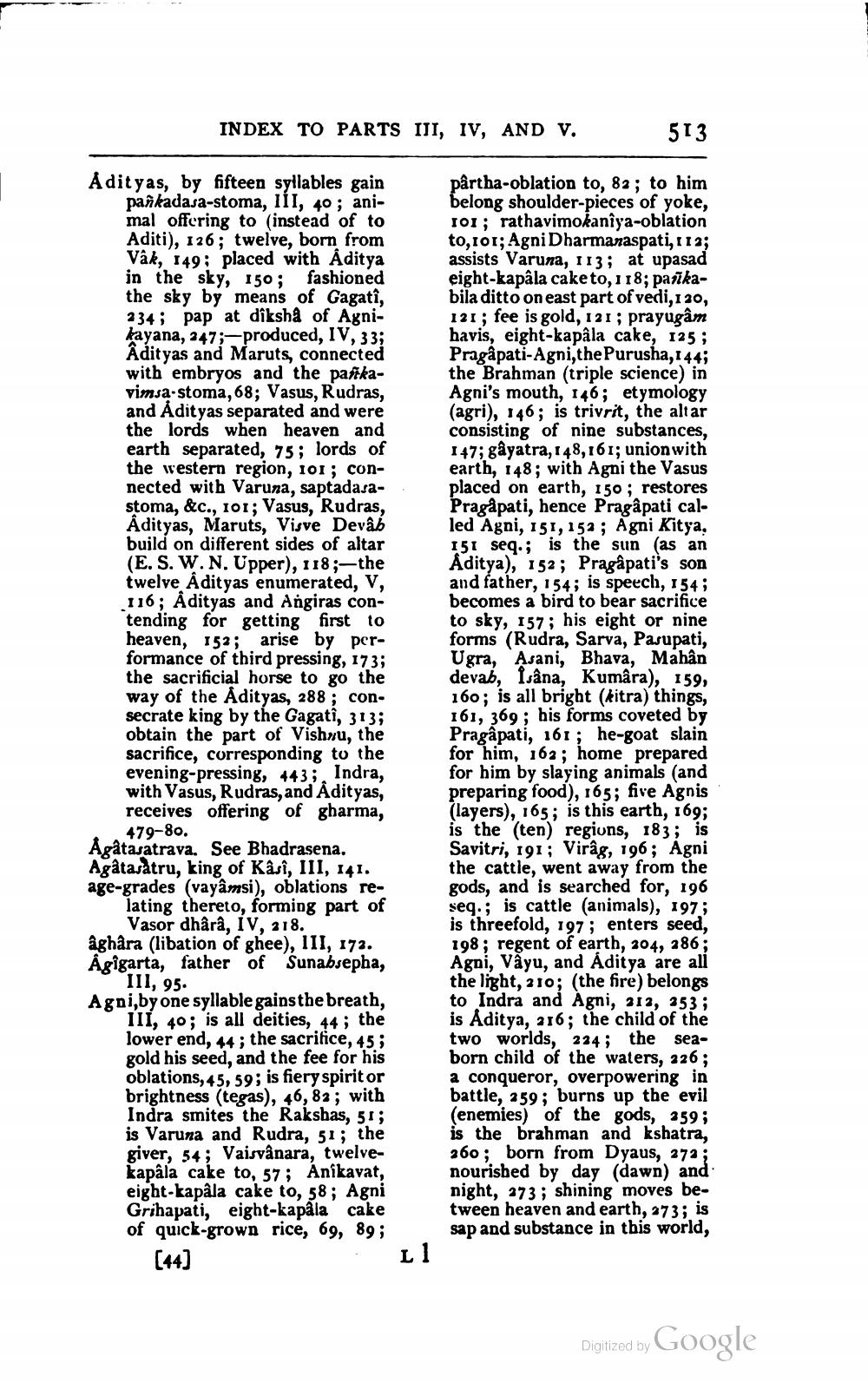________________
INDEX TO PARTS III, IV, AND V.
Adityas, by fifteen syllables gain pankadasa-stoma, III, 40; animal offering to (instead of to Aditi), 126; twelve, born from Vâk, 149; placed with Aditya in the sky, 150; fashioned the sky by means of Gagatî, 234; pap at dîksha of Agnikayana, 247;-produced, IV, 33; Adityas and Maruts, connected with embryos and the pankavimsa-stoma, 68; Vasus, Rudras, and Adityas separated and were the lords when heaven and earth separated, 75; lords of the western region, 101; connected with Varuna, saptadasastoma, &c., 101; Vasus, Rudras, Adityas, Maruts, Visve Devâb build on different sides of altar (E. S. W. N. Upper), 118;-the twelve Adityas enumerated, V, 116; Adityas and Angiras contending for getting first to heaven, 152; arise by performance of third pressing, 173; the sacrificial horse to go the way of the Adityas, 288; consecrate king by the Gagatî, 313; obtain the part of Vishnu, the sacrifice, corresponding to the evening-pressing, 443; Indra, with Vasus, Rudras, and Adityas, receives offering of gharma, 479-80.
Agâtasatrava. See Bhadrasena. Agâtasatru, king of Kâsî, III, 141. age-grades (vayâmsi), oblations re
lating thereto, forming part of Vasor dhârâ, IV, 218. âghâra (libation of ghee), III, 172. Ágigarta, father of Sunabsepha, III, 95. Agni,by one syllable gains the breath, III, 40; is all deities, 44; the lower end, 44; the sacrifice, 45; gold his seed, and the fee for his oblations, 45, 59; is fiery spirit or brightness (tegas), 46, 82; with Indra smites the Rakshas, 51; is Varuna and Rudra, 51; the giver, 54; Vaisvânara, twelvekapâla cake to, 57; Anikavat, eight-kapâla cake to, 58; Agni Grihapati, eight-kapala cake of quick-grown rice, 69, 89;
[44]
513
pârtha-oblation to, 82; to him belong shoulder-pieces of yoke, 101; rathavimokanîya-oblation to,101; Agni Dharmanaspati, 112; assists Varuna, 113; at upasad eight-kapâla cake to, 118; pankabila ditto on east part of vedi,1 20, 121; fee is gold, 121; prayugâm havis, eight-kapâla cake, 125; Pragapati-Agni,the Purusha,144; the Brahman (triple science) in Agni's mouth, 146; etymology (agri), 146; is trivrit, the altar consisting of nine substances, 147; gâyatra, 148, 161; union with earth, 148; with Agni the Vasus placed on earth, 150; restores Pragapati, hence Pragâpati called Agni, 151, 152; Agni Kitya. 151 seq.; is the sun (as an Aditya), 152; Pragâpati's son and father, 154; is speech, 154; becomes a bird to bear sacrifice to sky, 157; his eight or nine forms (Rudra, Sarva, Pasupati, Ugra, Asani, Bhava, Mahân devab, Isâna, Kumâra), 159, 160; is all bright (kitra) things, 161, 369; his forms coveted by Pragapati, 161; he-goat slain for him, 162; home prepared for him by slaying animals (and preparing food), 165; five Agnis (layers), 165; is this earth, 169; is the (ten) regions, 183; is Savitri, 191; Virâg, 196; Agni the cattle, went away from the gods, and is searched for, 196 seq.; is cattle (animals), 197; is threefold, 197; enters seed, 198; regent of earth, 204, 286; Agni, Vayu, and Aditya are all the light, 210; (the fire) belongs to Indra and Agni, 212, 253; is Aditya, 216; the child of the two worlds, 224; the seaborn child of the waters, 226; a conqueror, overpowering in battle, 259; burns up the evil (enemies) of the gods, 259; is the brahman and kshatra, 260; born from Dyaus, 272; nourished by day (dawn) and night, 273; shining moves between heaven and earth, 273; is sap and substance in this world,
L1
Digitized by
Google




